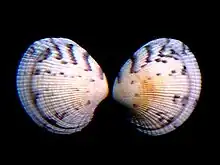Codakia orbicularis
Codakia orbicularis , or the tiger lucine,[1] is a species of bivalve mollusc in the family Lucinidae. It can be found along the Atlantic coast of North America, ranging from Florida to the West Indies.[2]
| Codakia orbicularis | |
|---|---|
 | |
| Scientific classification | |
| Domain: | Eukaryota |
| Kingdom: | Animalia |
| Phylum: | Mollusca |
| Class: | Bivalvia |
| Order: | Lucinida |
| Superfamily: | Lucinoidea |
| Family: | Lucinidae |
| Genus: | Codakia |
| Species: | C. orbicularis |
| Binomial name | |
| Codakia orbicularis | |
| Synonyms | |
| |
Description
Codakia orbicularis grows to maximum length of about 85 mm (3.3 in). The shell valves are nearly circular, the outer surface being sculptured with fine concentric rings and closely-packed radial lines. The lunule, a depressed area near the hinge, is heart-shaped, with the right valve lunule being larger than the left. The periostracum, a thin outside layer, is brown and the valves are mainly white; there is often a pinkish tinge near the interior margin. The shell is more laterally compressed than the smaller dwarf tiger lucine (Ctena orbiculata).[3] Like other members of its family Lucinidae, Codakia orbicularis does not have an inhalant siphon, instead rolling its elongated foot into a mucus-lined tube and drawing water into the gill cavity through this. It does have an exhalant siphon which is formed from a highly extensible mantle flap and can be inverted and drawn back into the shell.[4] The gill cavity contains chemosymbiotic sulphur-oxidizing bacteria housed in bacteriocytes which contribute to the clam's nutritional requirements.[5][6]
Distribution and habitat
Codakia orbicularis is native to the western Atlantic Ocean where its range includes from Florida and the northern coast of the Caribbean Sea. It lives immersed in soft sediment on the seabed, typically in Thalassia testudinum seagrass beds. Its maximum depth is 93 m (305 ft).[1] The bacterial symbionts enable these burrowing bivalves to colonise sulfide-rich sediments with low oxygen levels that are unsuited to many other bivalves.[7]
Ecology
Codakia orbicularis is a large edible shellfish and its life cycle has been studied to see whether it is suitable for mariculture. In the Bahamas, spawning takes place between May and October. The large-yolked eggs are enclosed in a thick gelatinous membrane and the early developmental stages take place inside this capsule. The later stages of the veliger larva are planktonic and metamorphosis occurs about 16 days after fertilisation. During their growth and development, the larvae may obtain nutrition from the symbiotic chemosynthetic bacteria present in their tissues.[8]
References
- Tunnell, John Wesley (2010). Encyclopedia of Texas Seashells: Identification, Ecology, Distribution, and History. Texas A&M University Press. p. 425. ISBN 978-1-60344-337-1.
- Abbott, R.T. & Morris, P.A. A Field Guide to Shells: Atlantic and Gulf Coasts and the West Indies. New York: Houghton Mifflin, 1995. 52.
- Leal, J.H. "Codakia orbicularis (Linnaeus, 1758)". Southwest Florida Shells. Retrieved 26 December 2020.
- Barnes, P.A.G. "Eco-physiology of the endosymbiont-bearing lucinid bivalve Codakia orbiculata". Retrieved 23 December 2020.
- Frenkiel, L. & Mouëza, M. (1995). "Gill ultrastructure and symbiotic bacteria in Codakia orbicularis (Bivalvia, Lucinidae)". Zoomorphology. 115: 53–61. doi:10.1007/BF00397934. S2CID 23223958.
- Taylor, John D. & Glover, Emily A. (2000). "Functional anatomy, chemosymbiosis and evolution of the Lucinidae". Geological Society, London, Special Publications. 177: 207–225. doi:10.1144/GSL.SP.2000.177.01.12. S2CID 129806177.
- van der Heide, Tjisse; Govers, Laura L.; Fouw, Jimmy de; Olff, Han; van der Geest, Matthijs; van Katwijk, Marieke M.; Piersma, Theunis; van de Koppel, Johan; Silliman, Brian R.; et al. (2012-06-15). "A three-stage symbiosis forms the foundation of seagrass ecosystems". Science. 336 (6087): 1432–1434. Bibcode:2012Sci...336.1432V. doi:10.1126/science.1219973. hdl:11370/23625acb-7ec0-4480-98d7-fad737d7d4fe. ISSN 0036-8075. PMID 22700927. S2CID 27806510.
- Alatalo, Philip; Berg, Carl J., Jr. & D'Asaro, Charles N. (1984). "Reproduction and development in the lucinid clam Codakia orbicularis". Bulletin of Marine Science. 34 (3): 424–434.
{{cite journal}}: CS1 maint: multiple names: authors list (link)